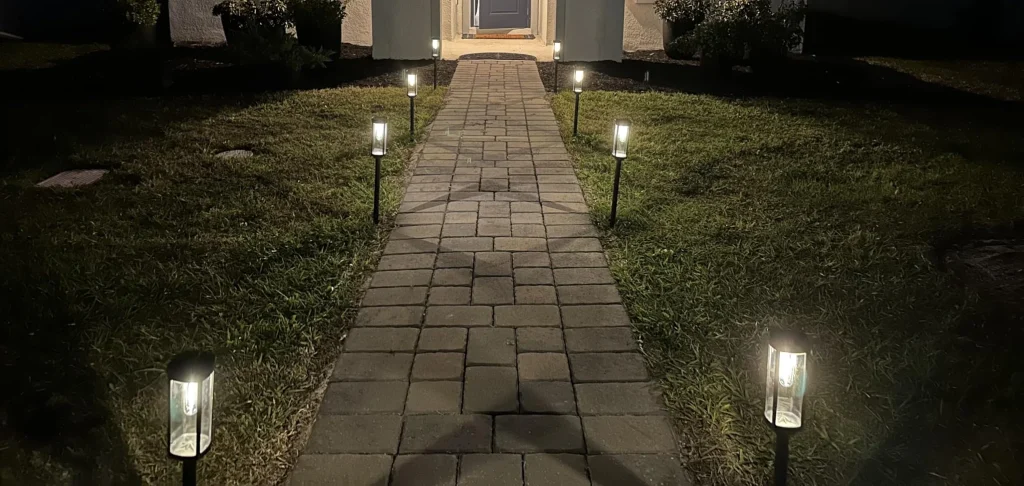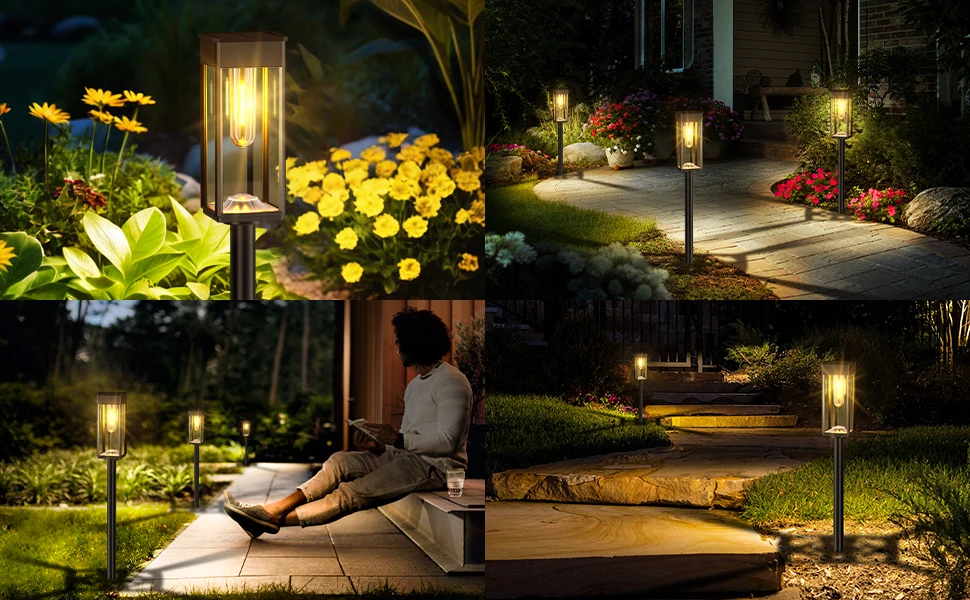Solar lights are a sustainable, cost-effective solution for outdoor lighting, harnessing sunlight to illuminate gardens, pathways, and patios. However, during dark, cloudy days or in regions with limited sunlight, maintaining their performance can be challenging. Reduced daylight hours or overcast skies can hinder solar panel efficiency, leading to dim or non-functional lights. Fortunately, alternative charging methods and strategic practices can keep solar lights glowing even without direct sun. This article explains the importance of maintaining solar light functionality in low-light conditions, explores alternative charging techniques, recommends models with backup charging options, and shares tips to optimize charging efficiency during cloudy weather.

The Importance of Charging Solar Lights Without Sun
Solar lights rely on photovoltaic panels to convert sunlight into electricity, stored in rechargeable batteries for nighttime use. In winter months or areas with frequent cloud cover, sunlight may be insufficient, reducing charge capacity and runtime. For example, Solar Us Shop notes that solar panels can lose up to 70% efficiency on heavily overcast days. This impacts safety, as unlit pathways increase tripping risks, and diminishes security, as dark perimeters may attract intruders. Maintaining consistent illumination is crucial for aesthetic appeal, such as highlighting garden features, and for practical purposes like ensuring safe navigation. Alternative charging methods and efficient practices allow users to bypass sunlight limitations, ensuring reliable performance year-round, especially in regions with prolonged cloudy or rainy weather.
Alternative Charging Methods for Solar Lights
When sunlight is scarce, several methods can charge solar lights effectively, using artificial light sources or backup power options. These techniques, drawn from expert advice and user practices, keep lights operational during dark or cloudy conditions.
- Artificial Light Charging
Indoor light sources, such as incandescent or LED bulbs, can charge solar panels, though less efficiently than sunlight. Place the solar panel 6–12 inches from a 100-watt incandescent bulb or a high-lumen LED (800+ lumens) for 8–12 hours, as recommended by Outdoor Solar Store. Avoid fluorescent lights, which emit insufficient UV light. Reddit users report success with this method, with one stating, “I used a desk lamp to charge my solar lights during a week of rain, and they worked fine.” Ensure the light source mimics natural daylight (5000–6500K) for best results, though charging may take longer than with sunlight. - USB or External Battery Charging
Some solar lights feature USB ports for direct charging, ideal for cloudy days. Connect the light to a USB power source, such as a laptop, power bank, or wall adapter, for 4–6 hours, per Solar Mentors’ 2025 guide. Alternatively, remove rechargeable batteries (e.g., AA Ni-MH) and charge them in a dedicated battery charger. This method ensures a full charge, bypassing solar panel limitations. Users on Amazon note that USB charging is a “game-changer” for winter, though not all models support this feature. - Backup Solar Panels or Power Stations
Portable solar panels or solar power stations can charge lights independently. Place a secondary panel in a sunnier location, if available, and connect it to the light’s battery via a compatible cable. Jackery’s 2025 blog suggests using a 20W portable panel to charge multiple lights. Alternatively, small solar generators can store energy for later use. This method suits off-grid setups but requires additional investment. A Reddit user shared, “My portable solar panel kept my lights going during a stormy week.” - Reflective Surfaces for Light Amplification
Positioning reflective materials, like mirrors or aluminum foil, near solar panels can enhance light capture on cloudy days. Angle the reflector to direct ambient light onto the panel, increasing efficiency by up to 20%, per Arka Energy’s 2024 tests. This low-cost method is effective in partially cloudy conditions but less reliable in complete darkness.

Recommended Solar Lights with Backup Charging Options
Not all solar lights support alternative charging, so selecting models with USB or battery flexibility is key. The following lights, chosen based on performance tests and user feedback, offer versatile charging and reliable illumination.
- Linkind Solar Spotlights (650 Lumens)
These spotlights feature a USB charging port, allowing direct charging on cloudy days. With a 650-lumen output and IP67 rating, they’re ideal for gardens or pathways. Tom’s Guide’s 2025 tests confirmed 10-hour runtimes after a 4-hour USB charge. Users on Amazon praise the USB feature, with one stating, “I charged them indoors during a storm, and they lit my driveway perfectly.” The adjustable head and color modes add versatility, though the plastic stakes may wobble in wind. - Beau Jardin Solar Path Lights (10 Lumens)
While primarily solar-powered, these lights use replaceable AA Ni-MH batteries, easily charged in a standard battery charger. Their IP65 rating ensures durability, as verified by Bob Vila in 2024. Amazon reviewers note, “I swap batteries during cloudy weeks, and they stay bright.” The elegant glass and metal design suits aesthetic setups, but the low lumen output is better for ambiance than security. - T-SUN Solar Spotlights (600 Lumens)
Equipped with a USB port and detachable solar panel, these lights offer flexible charging. Their IP65 rating and 600-lumen output make them suitable for highlighting trees or fences. Solar Mentors’ 2024 tests showed consistent performance after USB charging. A Wayfair user commented, “The USB option saved me during a rainy month.” The wide 120° beam angle maximizes coverage, though the panel’s cord length (10 feet) limits placement. - Otdair Solar Wall Lights (20 Lumens)
These wall-mounted lights feature removable AA batteries and a USB port, offering dual charging options. With an IP65 rating, they’re built for outdoor durability, as tested by Family Handyman in 2025. Users on Amazon appreciate the flexibility, with one saying, “I charge the batteries indoors, and they last all night.” Ideal for fences or patios, their compact design blends seamlessly, though brightness is modest.
Tips to Optimize Charging Efficiency on Cloudy Days
Maximizing solar light performance during overcast weather requires strategic planning and maintenance. These tips, drawn from expert sources and user insights, enhance charging efficiency and ensure consistent illumination.
- Clean Solar Panels Regularly: Dust, snow, or water droplets can reduce panel efficiency by up to 30%, per The Spruce (2025). Wipe panels weekly with a dry cloth, avoiding chemical cleaners that may damage surfaces. For snowy regions, gently brush off snow to maintain light absorption, as advised by Solar Us Shop.
- Optimize Panel Placement: Position panels south-facing at a 25–30° angle to capture diffuse light, even on cloudy days, per Outdoor Solar Store. Avoid shaded areas under trees or eaves. Adjustable panels, like those on T-SUN lights, allow seasonal repositioning for optimal charging.
- Use High-Efficiency Panels: Choose lights with monocrystalline solar panels, which perform better in low-light conditions than polycrystalline ones, as noted by Arka Energy. Models like Linkind and T-SUN use monocrystalline panels, ensuring faster charging.
- Leverage Backup Charging: For USB-compatible lights, keep a power bank or charger ready for extended cloudy periods. Charge batteries fully before reinstalling, as suggested by Consumer Reports (2025). For non-USB models, stock spare AA Ni-MH batteries (1000+ mAh) for quick swaps.
- Adjust Light Settings: Use low or medium brightness modes to extend runtime, especially for lights like Linkind with adjustable settings. Motion-sensor modes, available on T-SUN models, conserve energy by activating only when needed, per Solar Mentors.
- Store During Prolonged Low Light: If cloudy weather persists for weeks, store lights indoors to prevent battery drain, as recommended by Family Handyman. Remove batteries to avoid corrosion and wrap lights in a dry cloth. Test lights before reinstalling to ensure functionality.
Conclusion
Charging solar lights without sun is achievable with the right techniques and equipment, ensuring consistent illumination during dark, cloudy days. Artificial light sources, USB charging, backup panels, and reflective surfaces offer practical solutions to sunlight limitations. Models like Linkind, Beau Jardin, T-SUN, and Otdair provide versatile charging options, backed by strong user feedback and expert tests. By cleaning panels, optimizing placement, using efficient settings, and leveraging backup charging, you can maintain bright, reliable lighting. These strategies empower homeowners to keep their outdoor spaces safe, functional, and visually appealing, no matter the weather.


Leave a Reply